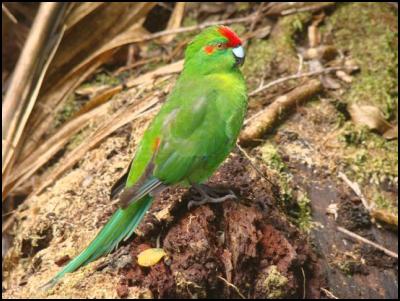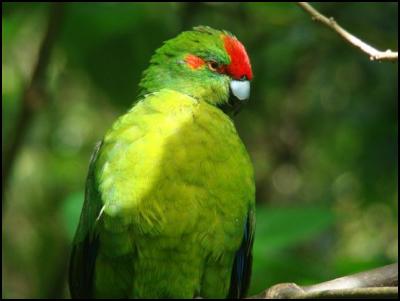Kakariki breeding on Motutapu 1st time in 100 yrs
December 3, 2009
Kakariki breeding on Motutapu for first time in 100 years
They’ve been gone for more than 100 years, but last week, a family of red-crowned parakeets was spotted flying down from the trees in a peaceful gully on Motutapu.

Click for big version
Luis Ortiz-Catedral, parakeet specialist and Massey University PhD student, says one of the birds was clearly a recently fledged juvenile that must have hatched on the island.
“I estimate it fledged about two weeks ago considering the size of the tail, the colouration of the beak and also because it was still being fed by its parents,” he says.
Red-crowned parakeets — one of five main species of kakariki — were recorded on Motutapu in September by the Ornithological Society of New Zealand (OSNZ). The OSNZ conducts bird surveys for the Motutapu Restoration Trust every year. Mr Ortiz-Catedral joined them last week to look for signs of breeding parakeets.
Only the male of the pair was banded, and had been released on nearby pest-free Motuihe eight months ago.
Motutapu and Rangitoto are on their way to becoming pest-free after the Department of Conservation began a two-year campaign to rid the islands of seven remaining mammalian pests in June this year.

Click for big version
Richard Griffiths, project manager for the Rangitoto and Motutapu restoration project, says it’s exciting to see kakariki back so soon — but says we must look after them.
“Now that native birds are nesting on the islands, it’s more important than ever before for visitors to ensure they don’t accidentally bring any pests with them,” he says.
While parakeets like to forage in open areas with bush close by to provide cover, the one factor that influences their survival the most is the presence or absence of predators, says Mr Ortiz-Catedral.
He says the fact that parakeets have made their own way to Motutapu so quickly after most of the pests were removed will attract international attention.
“Natural colonisations of islands by parrots are not common. The Hauraki Gulf is becoming a worldwide example of how restoring key sites can help surrounding islands too — it happens so often here that we tend to lose perspective.”
Motutapu Restoration Trust chair Chris Fletcher says that when Auckland artist Emily Karaka and her daughter planted the first of the now 500,000 trees on Motutapu, they dreamed this might happen one day.
“What better present for all the thousands of volunteers involved to have these kakariki breed on Motutapu just before Christmas,” she says.
Background information

Click for big version
The red-crowned parakeet was widespread on the mainland last century, but today is very rare on the mainland and only common on pest-free islands.
The International Union for Conservation of Nature (IUCN) has recently classified parakeets as a species vulnerable to extinction.
In the Auckland region, red-crowned parakeets are found on Tiritiri Matangi, Little Barrier, Great Barrier, Motuihe, Tawharanui Regional Park and now Motutapu.
They are also found on the Mercury Islands, the Hen and Chickens Islands and the Poor Knights Islands.
ENDS


 Alastair Thompson: Google's Support For Democracy And Media In NZ | Part 2 - Google & Scoop; A Brief History
Alastair Thompson: Google's Support For Democracy And Media In NZ | Part 2 - Google & Scoop; A Brief History Lobby for Good: Small Business Owners, MPs Rally Together To Demand Transparency In Tauranga Marine Precinct Sale
Lobby for Good: Small Business Owners, MPs Rally Together To Demand Transparency In Tauranga Marine Precinct Sale VisAble: National Apology Marks Important Step For Disabled Community, But True Change Requires Lasting Action
VisAble: National Apology Marks Important Step For Disabled Community, But True Change Requires Lasting Action NZ Government: Prime Minister Apologises For Abuse In Care
NZ Government: Prime Minister Apologises For Abuse In Care NZ Government: Govt Strengthens Protection For People In State Care
NZ Government: Govt Strengthens Protection For People In State Care Green Party: Govt Move To Exclude Journalist Risks Chilling Effect
Green Party: Govt Move To Exclude Journalist Risks Chilling Effect Taupo Neighbourhood Support: Secure Your Vehicle With Anti-theft Screws
Taupo Neighbourhood Support: Secure Your Vehicle With Anti-theft Screws


